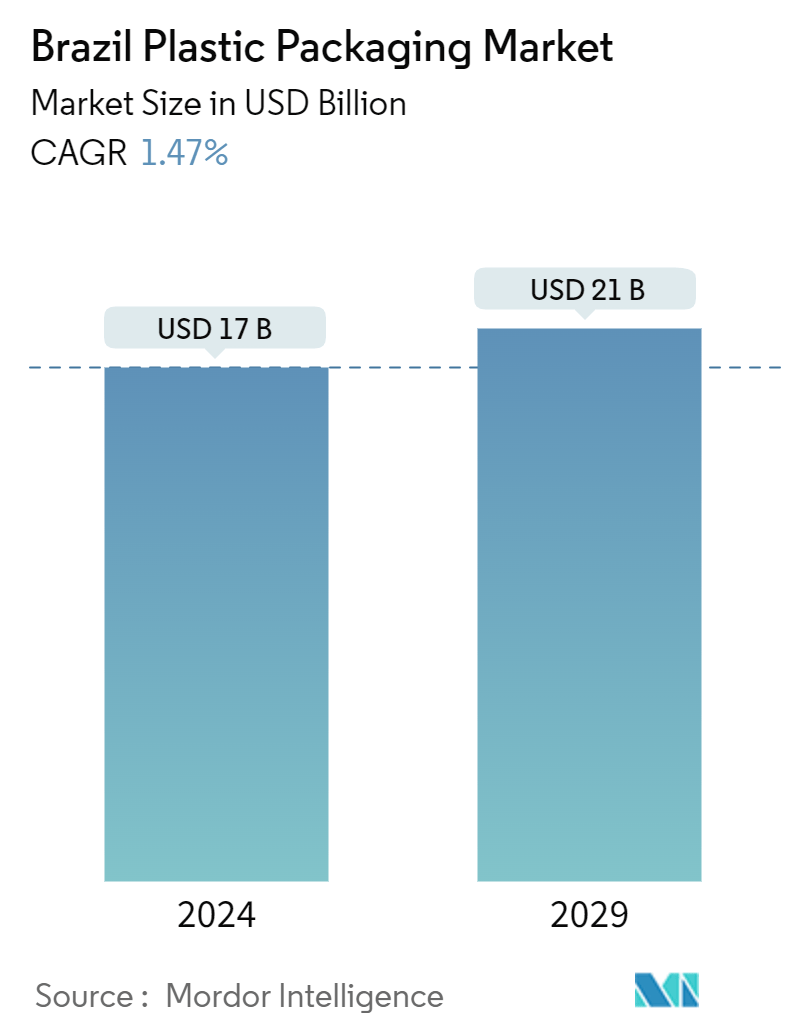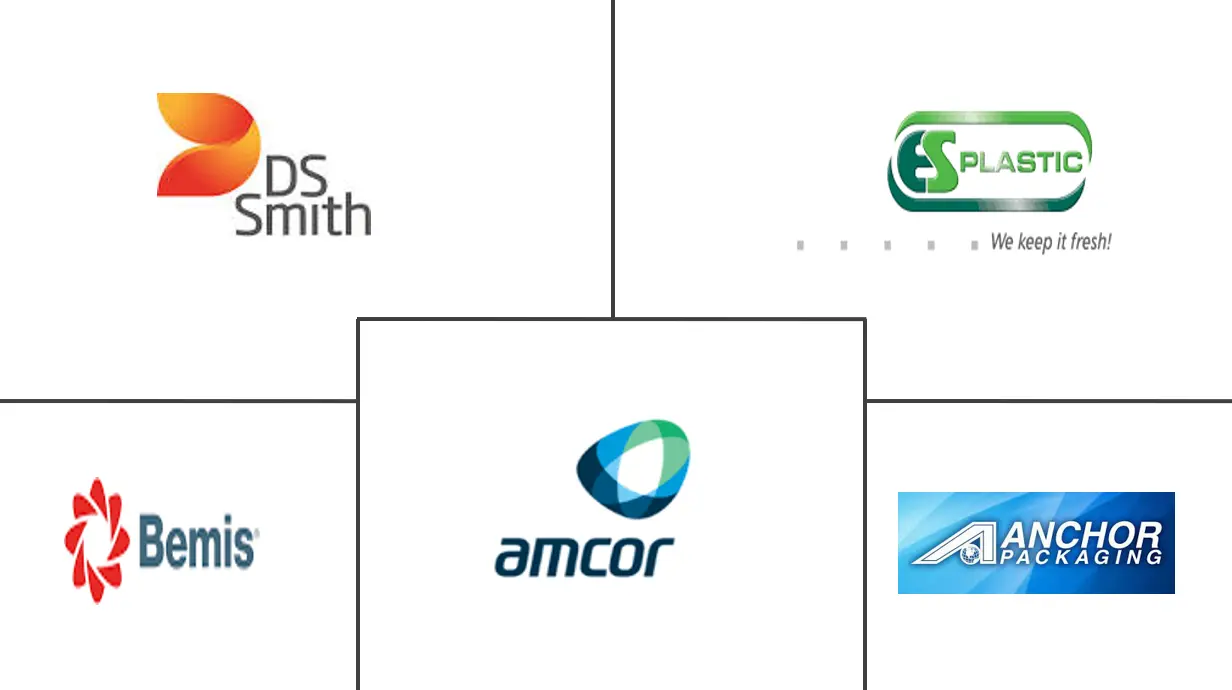Market Size of Brazil Plastic Packaging Industry

| Study Period | 2019 - 2029 |
| Base Year For Estimation | 2023 |
| Market Size (2024) | USD 17 Billion |
| Market Size (2029) | USD 21 Billion |
| CAGR (2024 - 2029) | 1.47 % |
| Market Concentration | Low |
Major Players
*Disclaimer: Major Players sorted in no particular order |
Brazil Plastic Packaging Market Analysis
The Brazil Plastic Packaging Market size is estimated at USD 17 billion in 2024, and is expected to reach USD 21 billion by 2029, growing at a CAGR of 1.47% during the forecast period (2024-2029).
- The utilization of plastic packaging has emerged as a crucial component for numerous enterprises, owing to its modern design that facilitates innovative packaging solutions. The swift growth of the food and beverage, personal care, and pharmaceutical industries, along with the increasing prevalence of organized and online retail globally, is anticipated to drive market expansion. A heightened emphasis on advanced packaging solutions, combined with the growth and development of the packaging sector, is a significant factor contributing to the rising demand for plastic packaging.
- Plastic packaging is an exceptionally lightweight and highly space-efficient option for storage. Its minimal storage requirements and ease of mobility significantly reduce the carbon footprint linked to transportation. Furthermore, it protects items from contamination, spoilage, and damage throughout the shipping and storage processes. The lightweight nature and resealable features enhance convenience for consumers when using and storing products. Moreover, the increasing prevalence of e-commerce brands is driving the demand for robust and protective plastic packaging to guarantee the secure delivery of goods to customers.
- According to ITA, Brazil is the largest economy in Latin America. The country accounted for a swift e-commerce growth rate of 14.3%, which is projected to surpass the value of USD 200 billion by 2026. The growth rate was largely a fallout of the COVID-19 pandemic, during which the Brazilian government utilized digital wallets for pandemic relief, granting millions their inaugural access to online retailers. Brazilian consumers have swiftly embraced the convenience and unique offers provided by e-commerce, facilitating the growth of online retail. As e-commerce sales in the region continue to rise, they present lucrative opportunities for players in the market.
- In Brazil, the demand for plastic packaging is propelled by industries such as personal care and cosmetics. Kao Corporation highlighted Brazil's prominence, ranking as the fourth-largest global market for beauty and personal care. Driven by shifting consumption trends among the rising middle-income demographic and Gen Z, the market is poised for a 7.7% annual growth rate. Data from IBGE, referencing the Brazilian Association of the Personal Hygiene, Perfumery and Cosmetics Industry (ABIHPEC), revealed that annual expenditures have consistently surpassed BRL 100 billion (USD 17.08 billion) over the last decade. Such substantial figures are expected to boost the demand for various types of plastic packaging solutions significantly.
- Plastic is expected to maintain its status as a favored material for consumer packaging solutions, representing a substantial portion of the consumer packaging sector in Brazil. Similar to other nations, Brazil is enhancing its waste collection infrastructure, which is crucial for generating high-quality post-consumer resin (PCR) that can be reintegrated into the manufacturing process. This initiative is vital for establishing a circular economy for plastic packaging. Furthermore, the Brazilian government has initiated legislation aimed at phasing out single-use plastics nationwide. These developments are likely to stimulate innovations within the sustainable plastic packaging market.
- Low-density polyethylene (LDPE), polypropylene (PP), high-density polyethylene (HDPE), and polyethylene terephthalate (PET) are among the most commonly utilized materials in the production of various items, including bottles, jars, trays, containers, wraps, films, and pouches. These materials are favored due to their cost efficiency, lightweight nature, versatile functionalities, and robust barrier properties against moisture. The increasing demand for sustainable packaging solutions is encouraging manufacturers to incorporate recycled plastic resins in the creation of these products.
- Several companies are investing and operating significantly in the region, helping them gain a competitive edge in the market. For instance, in the fiscal year 2023, Amcor capitalized on its distinctive position by collaborating with key stakeholders to enhance the recyclability of its packaging solutions. In May 2023, the Amcor Flexibles manufacturing facility in Londrina, Brazil, achieved the International Sustainability and Carbon Certification Plus (ISSC Plus) status, which facilitated the integration of advanced recycled materials across its product offerings.
- The elasticity of polyethylene (PE) packaging may diminish with extended use, leading to compression or deformation of the contained product. Furthermore, the physical characteristics of PE plastic materials, including films, such as reduced elasticity and an inability to satisfy the demands of applications that require resistance to fire and aggressive chemicals, are expected to pose considerable challenges to the adoption of PE packaging throughout the forecast period.
Brazil Plastic Packaging Industry Segmentation
Plastic packaging encompasses the utilization of plastic materials for the containment, safeguarding, and transportation of a wide range of products. This form of packaging enables the protection, preservation, storage, and transport of goods through various methods.
The Brazilian plastic packaging market is segmented by material (polyethylene (PE), bi-orientated polypropylene (BOPP), cast polypropylene (CPP), polyvinyl chloride (PVC), ethylene vinyl alcohol (EVOH), and other material types), packaging type (rigid and flexible), product (bottles and jars, tub, cup bowls and trays, intermediate bulk containers, pouches, and others), and end user (food, beverage, cosmetics and personal care, and others). The market sizes and forecasts are provided in terms of value (USD) for all the above segments.
| By Material | |
| Polyethene (PE) | |
| Bi-orientated Polypropylene (BOPP) | |
| Cast polypropylene (CPP) | |
| Polyvinyl Chloride (PVC) | |
| Ethylene Vinyl Alcohol (EVOH) | |
| Other Material Types |
| By Packaging Type | |
| Rigid | |
| Flexible |
| By Product | |
| Bottles and Jars | |
| Tub, Cup Bowls and Trays | |
| Intermediate Bulk Containers | |
| Pouches | |
| Others |
| By End-User | |
| Food | |
| Beverage | |
| Cosmetics and Personal Care | |
| Others |
Brazil Plastic Packaging Market Size Summary
The Brazil plastic packaging market is poised for growth, driven by the increasing demand across various sectors such as food and beverages, personal care, and pharmaceuticals. The market's expansion is supported by the rising penetration of organized and e-retail, which has been further accelerated by the COVID-19 pandemic. The pandemic initially posed challenges with a shift towards reusable packaging, but it also spurred a surge in demand for single-use plastics, particularly in nutritional drinks and healthy food products. This demand led to significant expansions in manufacturing facilities, supported by government initiatives. The market is characterized by the use of materials like low-density polyethylene, polypropylene, high-density polyethylene, and polyethylene terephthalate, which are favored for their cost-effectiveness, lightweight nature, and strong barrier properties. The growing focus on advanced and convenient packaging solutions is also contributing to the market's growth trajectory.
The flexible plastic packaging segment is expected to experience substantial growth, driven by its increasing application in end-use industries such as food, beverage, cosmetics, personal care, and pharmaceuticals. The rise in modern retailing, higher consumer income, and the boom in e-commerce, particularly in emerging economies, are key factors supporting market expansion. The demand for flexible packaging has been further bolstered by the shift towards online shopping for daily staples and fresh food, a trend accelerated by the pandemic. The food industry, a major consumer of plastic packaging, is increasingly replacing traditional materials with rigid plastic due to its advantageous properties. Innovations in packaging technology and the growing preference for sustainable solutions, such as the use of recycled plastic resins, are also shaping the market landscape. The competitive environment is marked by the presence of major players who are focusing on expanding their customer base and enhancing their geographical presence.
Brazil Plastic Packaging Market Size - Table of Contents
-
1. MARKET DYNAMICS
-
1.1 Market Overview
-
1.2 Industry Value Chain Analysis
-
1.3 Industry Attractiveness - Porter's Five Forces Analysis
-
1.3.1 Threat of New Entrants
-
1.3.2 Bargaining Power of Buyers
-
1.3.3 Bargaining Power of Suppliers
-
1.3.4 Threat of Substitute Products
-
1.3.5 Intensity of Competitive Rivalry
-
-
1.4 Assessment of the Impact of Microeconomic Factors on the Market Studied
-
1.5 Market Drivers
-
1.5.1 Growing Geriatric Population and Prevalence of Diseases
-
1.5.2 Product Innovations such as Downsizing coupled with Relatively Low Costs
-
-
1.6 Market Restraints
-
1.6.1 Dynamic Nature of Regulations and Inability to Support Heavy Goods
-
-
-
2. MARKET SEGMENTATION
-
2.1 By Material
-
2.1.1 Polyethene (PE)
-
2.1.2 Bi-orientated Polypropylene (BOPP)
-
2.1.3 Cast polypropylene (CPP)
-
2.1.4 Polyvinyl Chloride (PVC)
-
2.1.5 Ethylene Vinyl Alcohol (EVOH)
-
2.1.6 Other Material Types
-
-
2.2 By Packaging Type
-
2.2.1 Rigid
-
2.2.2 Flexible
-
-
2.3 By Product
-
2.3.1 Bottles and Jars
-
2.3.2 Tub, Cup Bowls and Trays
-
2.3.3 Intermediate Bulk Containers
-
2.3.4 Pouches
-
2.3.5 Others
-
-
2.4 By End-User
-
2.4.1 Food
-
2.4.2 Beverage
-
2.4.3 Cosmetics and Personal Care
-
2.4.4 Others
-
-
Brazil Plastic Packaging Market Size FAQs
How big is the Brazil Plastic Packaging Market?
The Brazil Plastic Packaging Market size is expected to reach USD 17 billion in 2024 and grow at a CAGR of 1.47% to reach USD 21 billion by 2029.
What is the current Brazil Plastic Packaging Market size?
In 2024, the Brazil Plastic Packaging Market size is expected to reach USD 17 billion.

